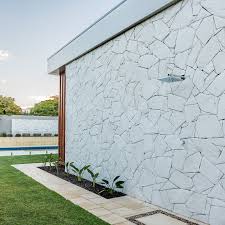Introduction
Building a stone clad wall is a rewarding project that adds both beauty and function to your property. But there’s one critical part many DIYers and even some professionals struggle with: properly finishing the bottom of the wall. This often-overlooked detail can make the difference between a wall that looks professionally installed and lasts for decades, versus one that deteriorates prematurely and looks amateurish.
In this guide, I’ll walk you through everything you need to know about finishing the bottom of your stone clad site wall properly. I’ve been working with stone for over 15 years, and I’ve seen firsthand what works and what doesn’t. Let’s get into it.
Why the Bottom Finish Matters
Before we dive into the how-to, let’s talk about why the bottom of your stone wall deserves special attention:
Water damage protection is probably the biggest reason. When rain hits the ground, it splashes back onto the wall. Without proper finishing, this water can seep behind your stone veneer, leading to all sorts of problems like mold, deterioration of your adhesive, and even structural damage in freezing conditions.
Then there’s the aesthetic factor. A well-finished bottom edge gives your wall a complete, intentional look. It’s like the difference between pants that are properly hemmed versus ones that are just cut off and fraying at the bottom.
And don’t forget about maintenance. A properly finished bottom edge makes it easier to trim grass and weeds around your wall without damaging either your landscaping tools or the stonework itself.
Common Bottom Finish Options
Let’s look at the most popular ways to finish the bottom of a stone clad wall:
1. Ground-Level Stone Cap
This is my personal favorite for most installations. A ground-level stone cap involves using specially cut stone pieces that create a slight projection from the wall face. These caps slope away from the wall to direct water away from the foundation.
Pros:
- Creates a clean, professional appearance
- Excellent water runoff management
- Protects the wall from lawnmower damage
- Defines the transition between wall and ground
Cons:
- Requires precise cutting and installation
- More expensive than some other options
- May require periodic releveling in areas with ground movement
2. Gravel Drainage Trench
Another excellent option is installing a gravel drainage trench at the base of your wall. This isn’t just a finish—it’s a functional water management system.
Pros:
- Superior drainage
- Prevents splash-back onto the wall
- Reduces weed growth against the wall
- Can be decorative with the right stone choice
Cons:
- Requires more excavation work
- Needs occasional cleaning and maintenance
- May trap leaves and debris
3. Concrete Curb or Footing
A concrete curb creating a clean transition between the ground and your stone wall is durable and practical.
Pros:
- Extremely durable
- Can be poured to follow contours of sloped ground
- Provides solid structural support
- Prevents soil erosion under the wall
Cons:
- Less aesthetic appeal unless dressed with stone facing
- Usually requires professional concrete work
- Creates a hard separation that may not suit natural-looking landscapes
4. Mortared Stone Base
This approach involves creating a slightly wider base using mortared stone, essentially creating a subtle “foot” at the bottom of your wall.
Pros:
- Visually appealing and integrated with the wall design
- Good water shedding capabilities
- Can be matched perfectly to the rest of your wall stone
- Provides a stable base
Cons:
- Labor-intensive installation
- Requires skill with mortar work
- May chip or crack if not properly installed
5. Landscape Edging
For more informal walls, installing landscape edging at the base can create a neat transition.
Pros:
- Relatively inexpensive
- Easy to install for DIYers
- Available in various materials to match your landscape
- Creates a clean mowing edge
Cons:
- Less durable than stone or concrete solutions
- May not provide adequate drainage
- Can look too casual for formal wall designs
Considerations Before Choosing Your Finish
Before you decide which method to use, take these factors into account:
Climate Conditions: If you live somewhere with freeze-thaw cycles, water management becomes even more critical. In this case, gravel trenches or well-designed cap stones with proper slope are your best bet.
Soil Type: Clay soils that retain water require more aggressive drainage solutions at the wall base. Sandy soils might allow you to focus more on aesthetics than drainage.
Wall Height and Purpose: Taller retaining walls need more robust bottom finishing than short decorative walls. Consider the load and pressure the wall will bear.
Surrounding Landscape: How will you maintain the area around your wall? If you’ll be mowing right up to it, a mower-friendly option like a concrete curb might be best.
Budget and Skill Level: Some finishes require specialized skills or tools. Be realistic about what you can accomplish yourself versus what might need professional help.
Step-by-Step Guide: Installing a Ground-Level Stone Cap
Since the ground-level stone cap is one of the most versatile and effective options, let’s walk through how to install one:
Materials You’ll Need:
- Cap stones (either manufactured or cut natural stone)
- Masonry adhesive
- Level
- Tape measure
- String line
- Rubber mallet
- Wet saw or angle grinder with masonry blade
- Caulking gun
- Landscape fabric
- Gravel
Step 1: Prepare the Ground
Start by digging a trench along the base of your wall that’s about 6 inches deep and 8-10 inches wide. The bottom of this trench should slope slightly away from your wall (about 1/4 inch per foot) to promote drainage.
Line this trench with landscape fabric, leaving enough excess to fold over the gravel later. This prevents weeds and keeps soil from mixing with your drainage gravel.
Fill the trench with about 2-3 inches of gravel and compact it firmly. The gravel provides a stable, well-draining base for your cap stones.
Step 2: Create a Level Reference Line
Using your string line and level, establish a level reference line slightly above ground level where the top of your cap stones will sit. This ensures your caps will have a consistent height all along the wall.
Remember that the top of your cap stones should be about 1-2 inches above the surrounding ground level. This prevents soil and mulch from washing over them.
Step 3: Dry-Fit Your Cap Stones
Place your cap stones along the trench without mortar or adhesive to see how they fit. Make any necessary cuts using your wet saw. Aim for tight, consistent joints between stones.
The caps should extend about 1-2 inches beyond the face of your wall to create a slight overhang that directs water away from the wall base.
Step 4: Install the Cap Stones
Once you’re satisfied with the layout, remove the stones and apply a generous amount of masonry adhesive to the prepared base. Set each stone in place, checking for level as you go.
Use your rubber mallet to gently tap the stones to the correct height and slope. The slight slope away from the wall is crucial for proper drainage.
Step 5: Fill Joints and Finish
After all cap stones are in place, fill the joints between them with more masonry adhesive or an appropriate mortar mix. Clean any excess before it dries.
Once the adhesive has cured according to the manufacturer’s instructions, fold the excess landscape fabric over the back portion of your gravel trench (the part closest to the wall). Add more gravel on top to fill the trench to just below your cap stones.
Backfill the outer edge of your trench with soil, creating a gentle slope away from the wall. This completes the drainage system while providing a smooth transition to the surrounding landscape.
Alternative Approach: Installing a Gravel Drainage Trench
If you prefer the gravel drainage trench approach, here’s how to do it right:
Step 1: Excavate the Trench
Dig a trench about 8-12 inches wide and 6-8 inches deep along the base of your wall. The bottom should slope away from the wall to direct water away from the foundation.
Step 2: Install Drainage Components
Line the trench with landscape fabric, extending it several inches up the wall face. This prevents soil from contaminating your drainage gravel.
If you’re dealing with significant water issues, consider adding a perforated drain pipe at the bottom of the trench, sloped to direct water to a suitable outlet point.
Step 3: Add Gravel
Fill the trench with clean drainage gravel. Use 3/4-inch clean stone or river rock for best results. Fill to within 1-2 inches of the surrounding ground level.
Step 4: Create a Decorative Top Layer (Optional)
For a more finished look, top your drainage gravel with a layer of decorative stone. Choose a color and size that complements your wall stone. Mexican beach pebbles or small river rocks work well for this purpose.
Step 5: Edge the Gravel
To keep your gravel trench neat, consider adding a subtle edging between the gravel and surrounding lawn or planting beds. Metal, plastic, or stone edging all work well for this purpose.
Maintaining Your Wall Base
Once you’ve properly finished the bottom of your stone wall, these maintenance tips will help keep it looking great for years:
Seasonal Inspection: Each spring, check for any signs of settling, erosion, or water damage at the base of your wall. Address any issues promptly before they worsen.
Clear Debris: Keep the base of your wall clear of leaves, soil, and plant debris that could trap moisture against the stone.
Control Vegetation: Don’t allow plants to grow too close to the wall base. Their roots can disturb your drainage system, and some climbing plants can damage the mortar between stones.
Regrade When Necessary: Over time, the ground around your wall may settle or erode. Periodically check that the ground still slopes away from your wall and regrade if necessary.
Clean Drainage Areas: If you installed a gravel drainage trench, remove debris occasionally and replenish gravel as needed to maintain proper drainage.
Troubleshooting Common Problems
Even with careful installation, problems can develop. Here’s how to address some common issues:
Water Pooling at Wall Base: This indicates poor drainage. You may need to regrade the area around your wall or install a more effective drainage system.
Efflorescence (White Powder on Stones): This mineral deposit indicates water is moving through your wall. Check your drainage and consider applying a water repellent sealer to your stonework.
Frost Heaving: In cold climates, poorly drained bases can freeze and push stones out of alignment. Improve your drainage and consider deeper gravel trenches below the frost line.
Crumbling Mortar at Base: This usually indicates excess moisture. Address the water source and repoint the damaged mortar with a high-quality, weather-resistant mortar mix.
Green Algae or Moss Growth: While sometimes desirable for a weathered look, excessive growth indicates too much moisture. Improve drainage and consider gentle cleaning with appropriate stone-safe products.
Final Thoughts
Properly finishing the bottom of your stone clad wall isn’t just about aesthetics—it’s about ensuring the longevity and structural integrity of your entire project. The extra time and materials spent on creating a proper finish will pay off many times over in reduced maintenance and repairs.
Remember that local conditions matter tremendously. What works perfectly in Arizona might fail quickly in Seattle. Don’t hesitate to consult with local stone masons or landscapers about best practices for your specific climate and soil conditions.
Whether you choose cap stones, gravel trenches, or another solution, the key principles remain the same: manage water effectively, create clean transitions, and protect the vulnerable bottom edge of your stonework. Get these basics right, and your beautiful stone wall will stand the test of time, looking great for decades to come.


Leave a Reply